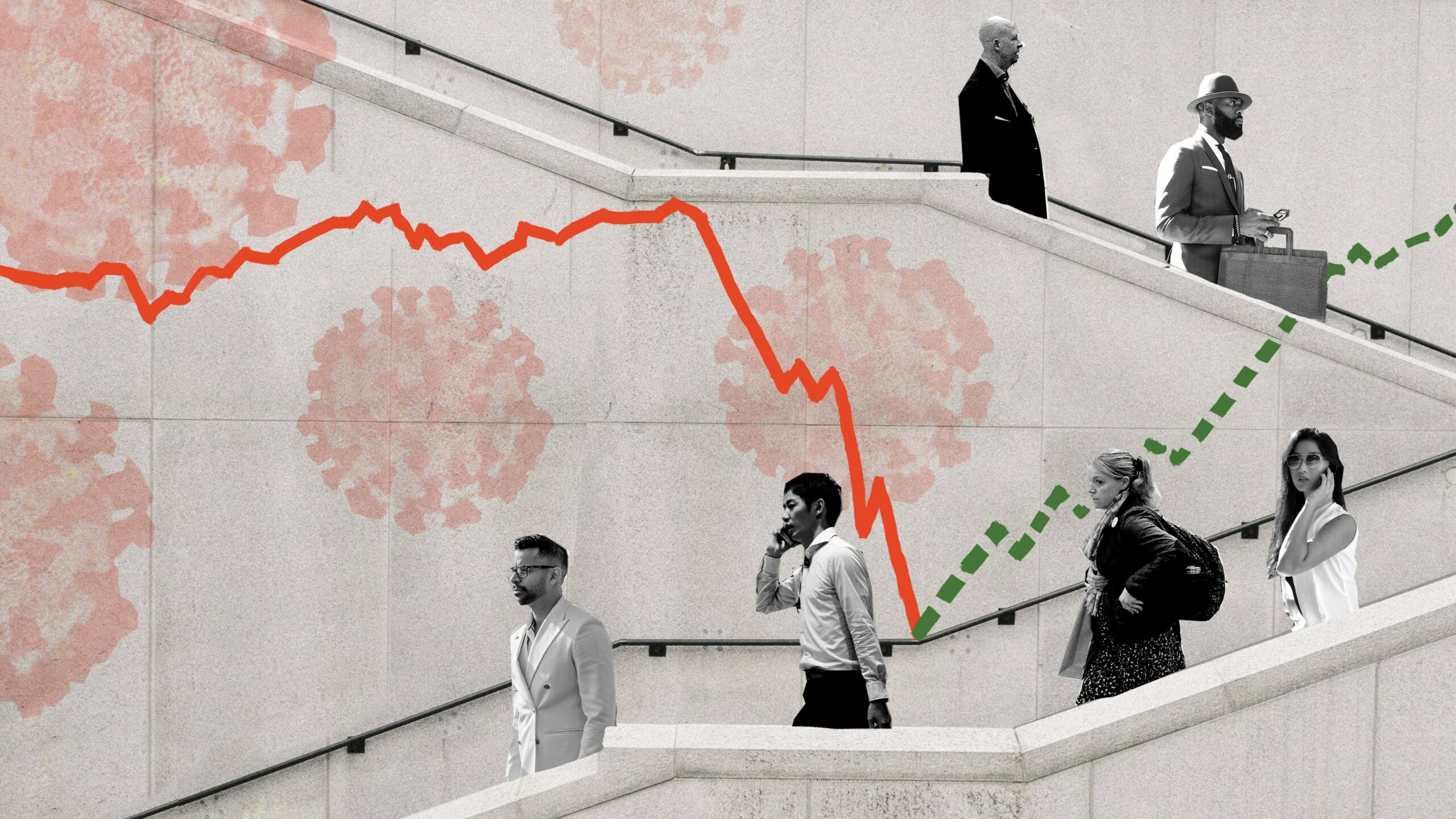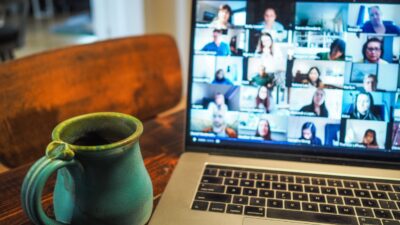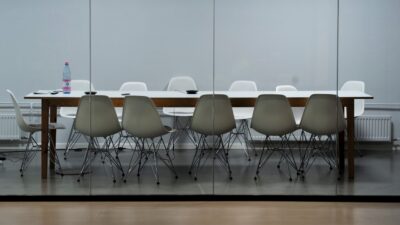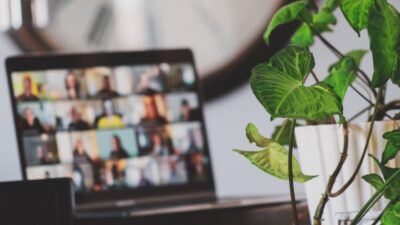Sandra Peter and Kai Riemer

Working from home on Corona Business Insights
Revisiting working from home (WFH): part one of a series looking at shifting working practices, distributed and hybrid work.
As COVID-19 sets out to change the world forever, join Sandra Peter and Kai Riemer as they think about what’s to come in the future of business.
Shownotes
Facebook extends its work-at-home policy
Tech giant Atlassian defies work from home trend with $1.4b HQ
Google is trying to create the ultimate post-pandemic office
JPMorgan’s Jamie Dimon back to office
Morgan Stanley bans unvaccinated staff and clients
Uber will ask employees to return to work 50% of the time
GM CEO Mary Barra’s return-to-work policy
Our previous episodes of Corona Business Insights on the ideal worker, zoom fatigue, starting a new job remotely, remote meetings, Gen Z and COVID-19, worker motivation, presenteeism and hybrid work, the four-day work week, employee monitoring, corporate surveillance, productivity and remote work, and office changes
This episode is part of a podcast series covering what COVID-19 will mean for the business world, where we look at the impact on the economy, businesses, industries, workers and society. This is part of our ongoing coverage of the impact of COVID-19 on the future of business.
Follow the show on Apple Podcasts, Spotify, Overcast, Google Podcasts, Pocket Casts or wherever you get your podcasts. You can follow Sydney Business Insights on Flipboard, LinkedIn, Twitter and WeChat to keep updated with our latest insights.
Send us your news ideas to sbi@sydney.edu.au.
Dr Sandra Peter is the Director of Sydney Executive Plus at the University of Sydney Business School. Her research and practice focuses on engaging with the future in productive ways, and the impact of emerging technologies on business and society.
Kai Riemer is Professor of Information Technology and Organisation, and Director of Sydney Executive Plus at the University of Sydney Business School. Kai's research interest is in Disruptive Technologies, Enterprise Social Media, Virtual Work, Collaborative Technologies and the Philosophy of Technology.
Share
We believe in open and honest access to knowledge. We use a Creative Commons Attribution NoDerivatives licence for our articles and podcasts, so you can republish them for free, online or in print.
Transcript
Intro From The University of Sydney Business School, this is Sydney Business Insights.
Sandra And this is Corona Business Insights. I'm Sandra Peter.
Kai And I'm Kai Riemer.
Sandra And we're back unpacking the impact of COVID-19 on business, the economy, industry, government, workers and society, and looking at the effects of the ongoing pandemic, while we're still in lockdown here in Sydney.
Kai And this podcast is part of a larger initiative by The University of Sydney Business School, and you can still find our COVID business impact dashboard online at sbi.sydney.edu.au/coronavirus.
Sandra And we're back taking a look at where the covid 19 pandemic has left us on a range of topics. And since we're all at home, we're revisiting, well, working from home.
Kai And this will be part one of a series looking at changes in our work practices and the future of hybrid work.
Sandra And in the next episodes, we will revisit productivity, wellbeing and relationships and culture, as we look at shifting work practices, distributed and hybrid work.
Kai But let's start with working from home. Since the first wave of the pandemic in 2020 I think we've learned a fair bit about the complexities and the challenges of working from home.
Sandra There was quite a bit of research before the pandemic on working from home but much of that has been updated and has changed. as we learn more and more about working from home since then.
Kai Yeah, before the pandemic, there's always been a widespread resistance to working from home. Set aside the fact that many people in many industries in essential jobs, in healthcare, in delivery and retail can't really work from home. But even in the areas where people could work from home before the pandemic, numbers were rather small, and organisations are often reluctant to allow people even one day of working from home.
Sandra And that's supported by data prior to the pandemic, for instance, UK data that showed that only about 5% of people worked from home as their main location, about 12% had worked from home in the previous week. And about a quarter said that they have worked from home at some point in the year prior to the pandemic.
Kai So that means that only a minority of people were working from home at all, and really a tiny fraction would work from home full-time.
Sandra That of course obscures some really sharp differences that existed even prior to the pandemic between different sectors and occupations. Obviously, there have been, for instance, more academics working from home, it's been a lot easier and more accepted in certain professions to work from home for longer periods of time. But there has been a trend over the past couple of decades of slowly increasing the number of flexible hours that people had in their jobs. And that's increased fivefold over the past two decades, with more and more of the workforce having some type of flexibility.
Kai And that flexibility is also one of location with the rise of coworking spaces and working from coffee shops, especially in the tech sector and other office-type work, you'd regularly see people working in the coffee shops across the city, at least for some part of their day. But everything changed with the pandemic, people were washed out of the office, also washed out of the cowork spaces and the coffee shops, and almost 100% of people who could work from home ended up working from home.
Sandra And that really was the case at the height of the pandemic, as is the case pretty much now in Sydney. Everybody who can must work from home. Over the last 18 months, we've learned quite a bit about working from home. Many companies have embraced working from home as an option. A study by Gartner last year showed that about 80% of company leaders plan to have their staff working from home at least part-time, more than 25% expected to spend more time working from home after the pandemic than it was the case before the pandemic.
Kai So 18 months on, where are we? We see many companies making announcements of their various models of where people will be working. And it's really a spectrum. It's a continuum from: everyone can work from home if they want to, they never have to come back to the office, to in the other extreme, some company leaders ordering everyone to come back to the office because you know, zooming isn't working, and the office is the nucleus of the activity of the company.
Sandra So before we look at the complexities associated with working from home long-term, let's look at some specific examples of what companies are doing. As you said, on the one hand there is the: you never have to come back-type companies.
Kai Yeah, so the never-come-backers, in that camp we have Twitter and Square, both companies headed up by Jack Dorsey who publicly announced that everyone can just 'keep working from home, you don't have to come back to the office ever.'
Sandra Yes, they are letting employees work from home forever. And then there's companies like Spotify, who adopted the work-from-anywhere model, which allows employees to work from wherever they want to. So if you never want to come back, you'll never have to go back. Similarly, companies like Salesforce said that they would allow workers to choose if they ever want to come back to the office again.
Kai And then we've got Facebook who in principle also allows everyone to work from home, but they are reopening their offices. And they are encouraging people to come back. And they've stipulated that if you come back, you have to commit to come back 50%, because they say that it is important to be present in the office, if you're coming that you have predictability, that you are there some of the time, and to build community in the office among the people who choose to come back to the office.
Sandra So Facebook's got about 60,000 people working for them, and they plan to reopen their offices. But as you've said, they will allow full-time employees to work from home, if their jobs can be done remotely, even across international borders.
Kai Yes. So in Europe, for example, they now allow you to pick the country where you want to live, you might actually be based in the UK office, but if you want to move to continental Europe, you can pick a different country and work from there and still remain employed, which adds another layer of flexibility for workers.
Sandra There's another range of companies that do allow for extreme flexibility, but that seemed to be signalling that things will be changing in the long-term. And they’re companies like Atlassian
Kai Yeah, Atlassian and also Google. Atlassian, the Australian tech giant. is building shiny new headquarters at Central Station. That announcement came just this week, a state-of-the-art building with a very positive ecological footprint, and what they call 'habitats', bespoke areas in the building for the kind of agile teamwork that is very common at tech companies like Atlassian.
Sandra The $1.4 billion new Atlassian headquarters do seem to be in contrast with the 'all of its staff working from home' current practices that Atlassian has in place, and that seemed to be working.
Kai Yeah. So if you work at Atlassian, you have to come back to the office four times a year, once a quarter. But at the same time, these new offices signal that face-to-face work is still valued. And Google is doing much the same. So in its new London headquarters, they're building shiny new facilities, including an indoor basketball court, a rooftop running track...
Sandra Collapsible furniture and balloon walls, it's going to be the 11-storey ground-scraper rather than skyscraper.
Kai And they're building these spaces to make it really attractive to come back to the office, because they're banking on the fact that when people work face-to-face, they build communities, they have ideas, and they might also be more productive.
Sandra So both Atlassian and Google seem to be signalling some sort of preparation for a hybrid model that will combine working from home, remote work with some sort of in person collaboration. Some companies, however, are more explicit in mandating some of the work be done in the office. Companies like Uber, who are asking employees to return to work 50% of the time, which can however, be split up any way the employees choose. Employees will have flexibility in their preferred office location, but they will have to be back in the office for at least 50% of the time.
Kai Then there's Apple who also go for a hybrid work model. Apple has been in the news because the company is denying people the ability to work from home permanently unless they have a valid medical reason for doing so, stipulating that everyone has to be in the office some of the time, because the kind of work that Apple does in innovation, they say require people to be in the office, and arguably hardware related work is fairly tactile. And so there might be good reason for why companies such as Apple want people in the office at least part of the time.
Sandra Apple is one of those companies that are signalling a return to the office. Tim Cook has been quite outspoken about expecting employees to come back to the office at least three days a week, which is also Apple's new hybrid work policy. The employees will have an option to work remotely a couple of days a week, but they will have to come back to the office.
Kai And then there's companies such as JPMorgan, where CEO Jamie Dimon famously announced that he was fed up with Zoom calls and the associated remote work, and that commuting to the office will make a strong comeback, ordering everyone to go back to the office because this is where work is being done.
Sandra And that has been echoed by Morgan Stanley, and by Goldman Sachs, which have called remote work and working from home a culture killer for companies and said that the default needs to be the office. Similarly, Morgan Stanley CEO has taken a very, very hard line on employees coming back to the office and warned that if people are not back, there might be consequences.
Kai So there seems to be differences between the tech sector which shows more flexibility and the banking and investment banking sector, which seems to be more driven by face-to-face contact. So Jamie Dimon says that JP Morgan reportedly lost business to rivals because their bankers weren't able to visit clients in person. And that that lesson led to the decision to order everyone back and resume business as usual from before the pandemic.
Sandra At this point, it's really tempting to just say, why don't we just let the employees find whatever works best for them, whether that might be 100%, at home or back in the office and take it from there. And to be fair, that's the direction that some companies have taken, like General Motors. And let's not forget, General Motors has more than 150,000 employees. And while some of them obviously need to be present in manufacturing facilities, many of them do not need to be there all the time.
Kai And the HR department of GM must have contemplated about the appropriate work from home policy long and hard, and probably couldn't quite figure out a model that would work and resorted to the simplest possible solution for a work from home policy, which is two words:
Sandra "Work appropriately". GM's CEO Mary Barra took to LinkedIn and said that the learnings from the past year of dealing with the COVID pandemic have prompted them to manage the future of work through a "work appropriately" policy. This means that where the work permits, employees have the flexibility to work where they can have the greatest impact on achieving their goals. The notion behind it, they said is a bit like their dress code: dress appropriately.
Kai And that sounds really nice, you know, everyone work the way they want to achieve their goal. If it wasn't for the fact that work is not an individual endeavour, it's not just up to the individual to decide this. Because many people work in teams, they work with clients, they work across different divisions in an organisation across different locations, they work with business partners, so to figure out where and when to work is not just up to the individual.
Sandra So while this does seem like a very sensible approach, one that takes into account a diversity of opinions and of work styles and demands on people's both work lives and personal lives, it is fraught with a number of complexities. First, there are the challenges of coordinating this across locations.
Kai Like in different states in the US, in different locations, cities here in Australia, or across countries in Europe, opening up doesn't all happen at the same time, at the same speed. Some areas might go back into lockdown, like we've now done here in Australia. So that adds to the complexity of opening up, of going back to the office or staying on Zoom given that work doesn't just happen in one location alone, but often across the different offices, across the different locations in one company.
Sandra And as you have said that is compounded by the different stages of the pandemic, the percentage of vaccinated people, certain companies have taken steps to say you can only come back to the office if you are vaccinated. Such as Morgan Stanley at their New York headquarters, which said that people coming into the office, whether they're employees or visitors, will need to be vaccinated before they do so.
Kai Another layer of complexity stems from the personal circumstances, be that family obligation, carer obligations, the home situation, whether work from home is even possible. We know that female employees take more of the childcare responsibilities, home-schooling, and therefore gravitate more to working from home, which in a hybrid environment can create inequalities that management will have to take into account as they derive the appropriate models.
Sandra There's also the home situation itself. We've seen during the pandemic that in countries like Japan, it was almost impossible for employees to work from home given the home arrangement, the size of the dwellings, the lack of an office space or desk at home from which these activities could be conducted. That is compounded by maybe more than one person in the household wanting to work from home. What happens when two people have to do stand ups or presentations at the same time?
Kai This can have noise implications in a small dwelling. Other problems stemmed from infrastructure, broadband network that doesn't support multiple children doing home-schooling and parents having to Zoom into the office.
Sandra And this takes us to another complexity associated, which is that employees might gravitate towards one or the other model. There are employees who have quit Apple because they need to or want to work from home permanently, even after the pandemic restrictions have eased. On the other hand, there are people who seek out community and collective in the workplace who want to go to work, who might be at the beginning of their careers, or in situations where building contacts, having networks and being in the company of people is something that they gravitate towards.
Kai Many people have shown intent to change employers, in the later stages of the pandemic has been called 'The Great Resignation'. So it really appears that people are now taking into account how they're being treated, what they're being offered by employers in regard to the work models as one factor of choosing where to work. As you said, some people might gravitate more towards community, especially younger workers who need to build a career on the basis of contacts and need to socialise more, might want to work with an employer that either mandates or at least encourages very strongly for people to come back to the office so that they don't get stuck in the isolation of work from home arrangements where only few people congregate in the office.
Sandra So where does this leave us with working from home? With respect to companies, it leaves us very much in a stage of experimentation, where things are still in flux. Many companies are still trying things out and reassessing things.
Kai Not only in terms of the flexibility of the models be it timing, be it location, but also in terms of what office spaces should now look like, should they be team workspaces? Should they be socialising spaces, meeting spaces? Or should we go back to the traditional open plan offices that was so common before the pandemic?
Sandra And of course, part of that story has to do with productivity has to do with wellbeing and things like relationship and culture, which is why this has been part one of a series of episodes looking at the future of our work practices and the future of remote and hybrid work.
Kai So join us next time on Corona Business Insights.
Sandra That's all we have time for today. Thanks for listening. Thanks for listening
Outro From The University of Sydney Business School this was Corona Business Insights, the podcast that explores the future of business in the wake of the global pandemic.
Sandra Connect with us on LinkedIn, Twitter, WeChat and Flipboard. And subscribe, like or leave us a rating wherever you get your podcasts.
Close transcript





